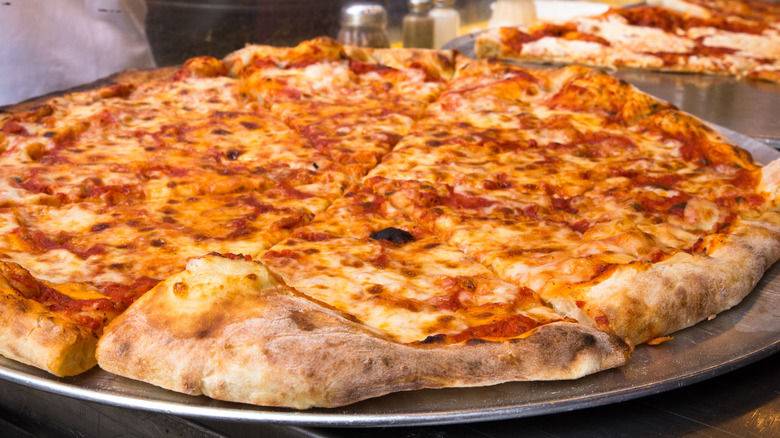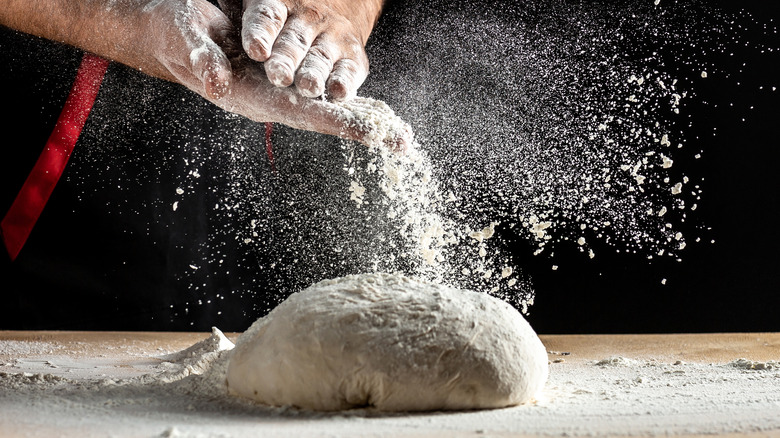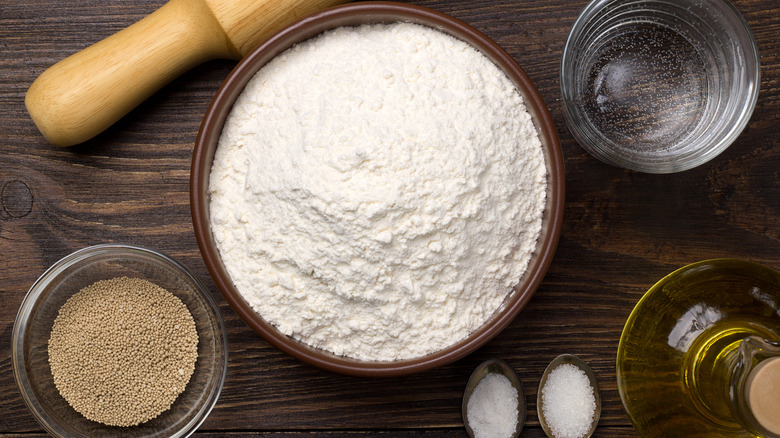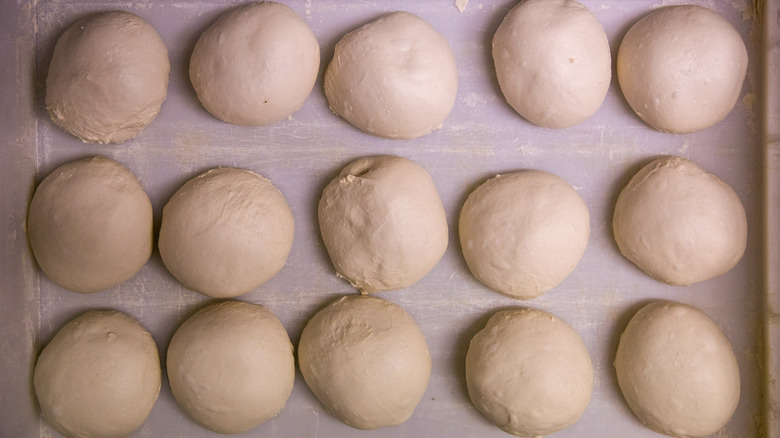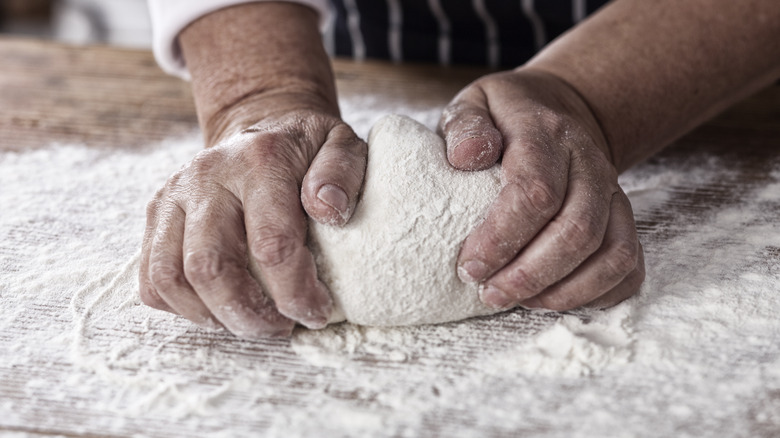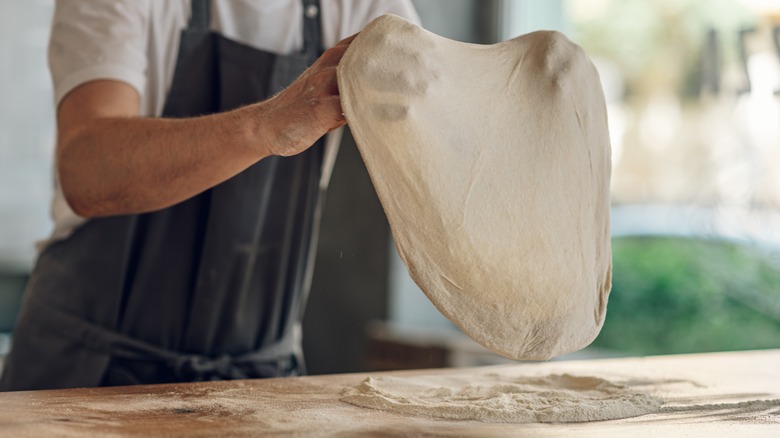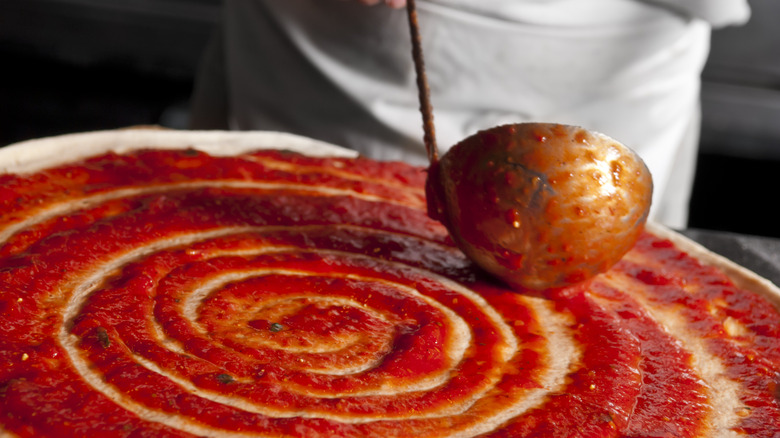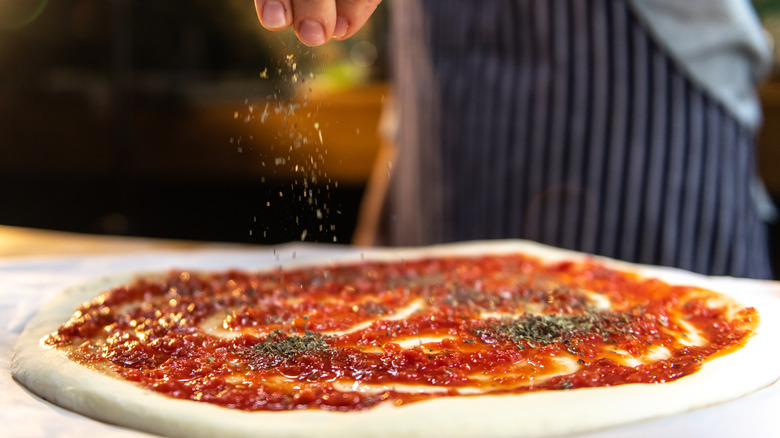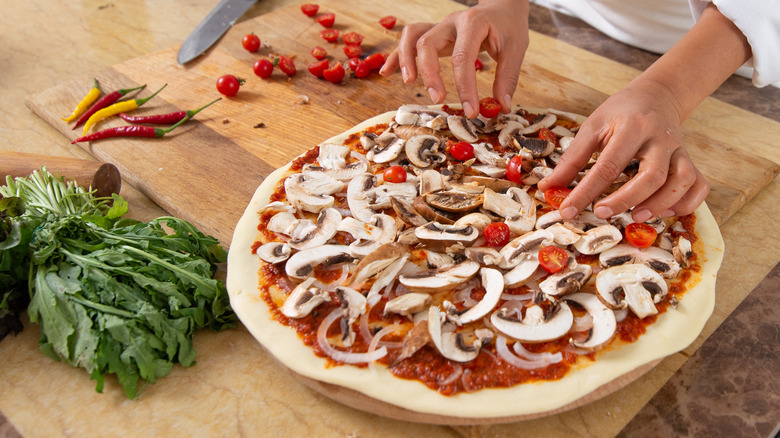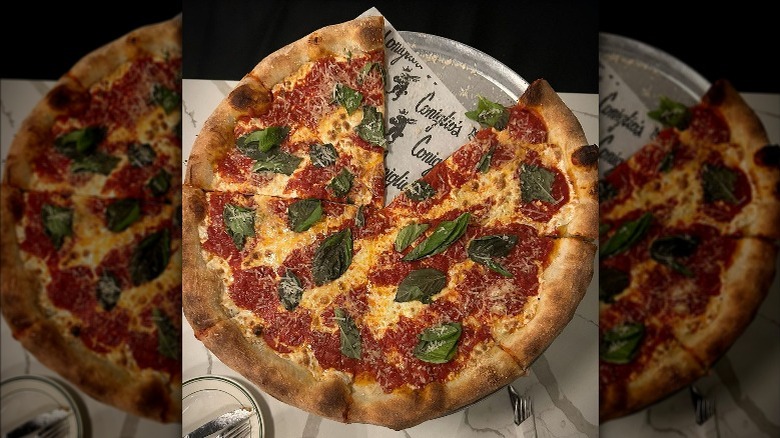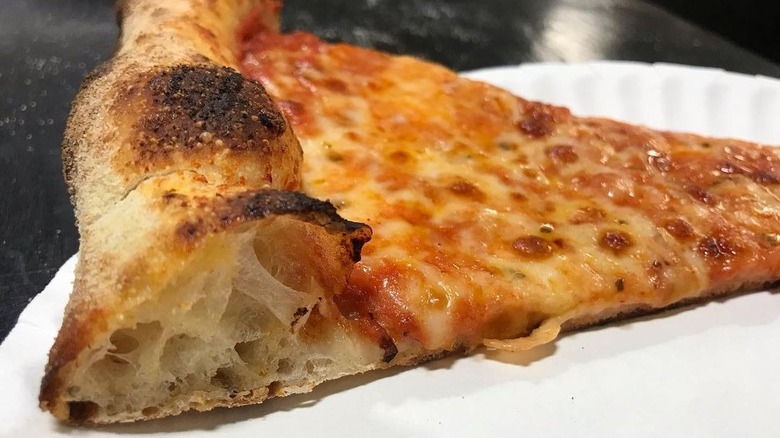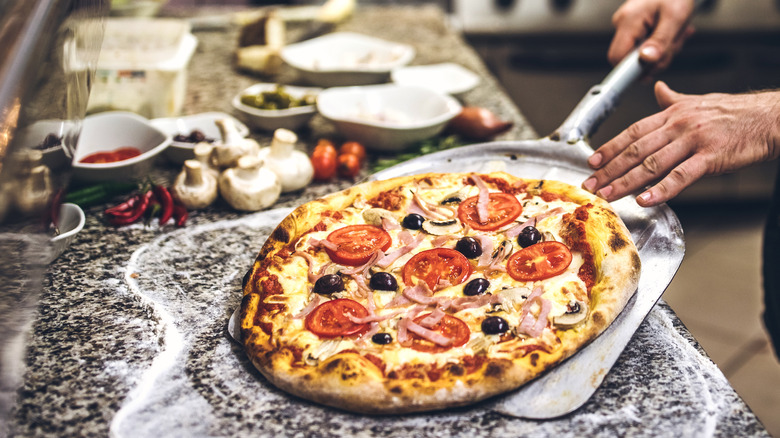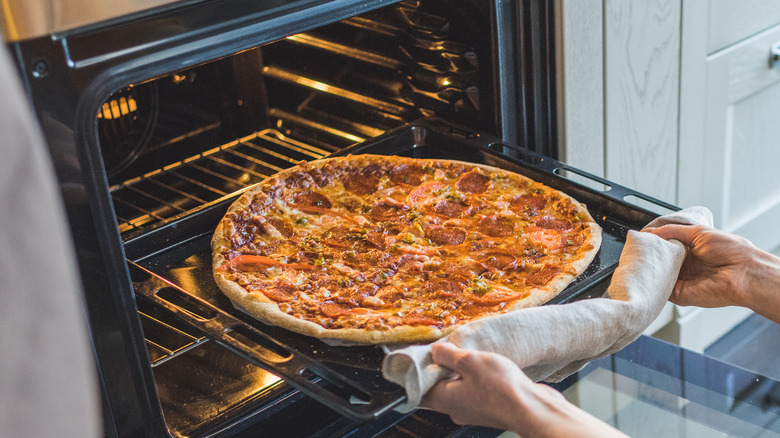13 Essential Tips For Making New York Pizza, From World Champion Pizzaiolo Nino Coniglio - Exclusive
There are few foods quite so iconic in Americana as a hot, bubbling slice of New York pizza. The crust is the perfect balance of chewy and crisp, the sauce is sweet and bright, and the cheese wraps it all up in a beautiful blanket of salty, gooey goodness. While nothing beats a hot and fresh slice eaten right on the street, if a trip to the Big Apple isn't in the cards, it is possible to make New York-style pizza at home. However, it requires some serious time, effort, and knowledge.
So Tasting Table spoke exclusively with one of the top pizza-makers on the planet, chef Nino Coniglio, for some expert advice. He's got more than 10 U.S. and World Champion Pizza Maker awards under his belt and currently runs six successful pizzerias in the heart of New York City, as well as his newest pizza shop, Coniglio's Old Fashioned in Morristown, New Jersey, near where the chef was born and raised.
Coniglio grew up on pizza, and he takes his passion very seriously, with an in-depth knowledge of the art and science that goes into authentic New York-style pizza. His pizza philosophy revolves around three core components: "high-quality ingredients, the order in which they are applied, and taking the time to master the true alchemy of dough making." Coniglio broke that down in detail, sharing his essential tips for making New York-style pizza at home. Follow his guidance, and you'll feel like you're in the Big Apple from the first bite.
1. Use the right flour
The heart and soul of a pizza is arguably the dough. And the backbone of a good pizza dough is using good flour. You'll find tons of flour options on grocery store shelves these days, but not all are created equal –- and certainly, not every type is right for pizza dough. Two particular flours that you'll often see used in pizza dough recipes are 00 flour (Italian flour ground to the smallest size possible) and bromated flour which is made from grain that made been treated with an oxidizing agent, potassium bromate — the addition is said to help make dough stretchier and fluffier with a shorter fermentation time.
However, Coniglio recommends skipping both varieties. "Forget about 00 flour for the rest of your life," he warns. "It's a marketing scheme that was concocted by corporations that rose out of the industrialization of agriculture and post World War II Italy." Unsurprisingly, it also happens to be more expensive. As for bromated flour, Coniglio points out that "potassium of Bromate is this hardcore carcinogen," and notes that "the only place that it's legal is America."
Your tastiest and safest bet when making pizza, according to Coniglio is to use regular old unbleached, unbromated flour. So read the labels carefully at the supermarket for the sake of your wallet, your health, and your tastebuds.
2. Get your dough ratio right
Creating perfect pizza dough starts out as more of a science before it becomes an art. You have to balance the right amounts of flour, yeast, hydration, oil, and salt to create the ideal consistency, and allow for proper fermenting, which creates the rise you want in your dough. Coniglio says the ideal ratio is a "62% hydration dough with 3% oil, 3% salt."
To make the math easy, we'll calculate based on 1,000 grams of flour, which will yield you about two large pizzas at the end of the day. For 62% hydration, you'll want to mix in 620 grams of water, along with active dry yeast at around a 1% ratio, so roughly 10 grams. "Mix that up, leave it out for two hours, throw it in the fridge," says Coniglio.
While there are differing opinions about when to add oil to pizza dough, Coniglio opts to wait until it has fully hydrated. So the next day, after your dough has had a chance to rise and ferment, you then want to add 30 grams each (3%) of salt and olive oil to the dough before you knead it and get it ready to stretch. Yes, it's a process that will likely require a digital scale and calculator to get right, but the results will be well worth it.
3. The type of olive oil you use matters
A major flavor component of pizza dough is olive oil. So it stands to reason that you should splurge on the good stuff if you're going out of your way to make New York-style pizza from scratch. But before you reach for the fanciest-looking bottle, be warned. Coniglio notes that nearly "all olive oils on the store shelves in the United States and beyond are completely fake" and mixed with lower quality olives and cheap filler ingredients.
On top of that, he notes that even a bottle from a reputable brand is going to lose its fresh flavor before you get around to using it since most people buy olive oil in one or three-liter bottles."[O]nce you crack that seal, you get about three days," Coniglio warns. After that brief window, "all the flavonoids and all the healthy stuff in oxidize are gone."
With that in mind, Coniglio advises to shop small and local. He recommends California-made Corto olive oil, but If your heart is set on a pure Mediterranean olive oil, stick with a small batch bottle from Greece of Italy that you'll use up right after opening. "If you can get your hands on great Sicilian olive oil and you're going to use it quick enough, go for it."
4. Be patient, it's going to take days
While delivery services and frozen options have made it possible to enjoy a pizza within 20 minutes of when a craving strikes, the true process for bringing you that perfect pie takes much longer. And if you want to try your hand at making NY-style pizza at home, then the only thing you're going to need more of than flour and cheese is patience.
The process for making pizza dough from scratch can take up to three or four days if "you're going to make it right," says Coniglio. After you've created your dough and let it develop in the fridge overnight, it's time to knead followed by an hour-long rest. The dough is shaped into a ball and placed back in the fridge to chill for another two to three days. That may seem like an unbearable amount of time to wait, but "this is just the reality of bread and pizza," he insists. This process allows the yeast to further ferment, not only developing delicious flavor but causing the dough to rise and get airy, creating the unique, chewy texture that we know and love in a NY pizza crust.
All that patience will pay off in another way as well. Coniglio points out that "fermenting a dough properly is going to make it stretch a lot easier for the average person."
5. You don't need to knead as much as you think
Some people are understandably put off by the idea of making their own pizza because the work of kneading the dough to the proper consistency seems like more trouble than it's worth. However, Coniglio insists that you shouldn't let that misconception hold you back. As he explains, "time is going to do a lot of the work for you."
According to Coniglio, the structure and bounce you're seeking will come naturally if you let it sit, so there's no need to put in a vigorous 10-minute workout. Instead, he suggests that you should work the dough for about two minutes, and then "save yourself a whole eight minutes by just leaving it for an hour or two."
The process couldn't be more simple (and easier on the muscles) if you follow Conligio's gameplan: "Mix everything together. Wait an hour, do a two-minute knead, scale, shape, you're done ... Just put it in the fridge and wait."
6. When it comes to stretching out the dough, practice makes perfect
Another daunting step in the pizza-making process is stretching your thick ball of dough out into a flat, round pizza shape. (Unfortunately for those seeking the easier method, true NY-style pizza is stretched, not rolled out with a rolling pin.) If you've been to a pizzeria in the Big Apple, you've likely seen the chefs in the back tossing dough around in the air, catching it from one arm to the next like it's nothing. Of course, the technique is not that simple, but it is possible to master the skill.
Coniglio recommends going to your local pizzeria and asking to buy a 50-pound bag of commercial flour. (You can order it off Amazon as a last resort, but he warns it's going to cost way more.) "Then you're going to get 60 dough balls ... and you're just going to stretch and throw 'em in the garbage," he says. Coniglio argues that, while this seems like a waste, it's not: "It's given you a lifelong skill that you could pass on to your family."
For those who just can't bear the thought of dumping all that dough, there is another way to practice this valuable skill. "Go online and buy a rubber pizza dough, and just watch some YouTube video videos and practice for 10 hours," suggests Coniglio. "Then you'll probably be there."
7. Pizza sauce really only needs three ingredients
Once your dough is nicely formed, it's time for the fun step of actually building your pizza with toppings. That starts with sauce, and we can't stress enough how important it is to start with a good quality sauce as the base flavor of your pizza. But Coniglio let us in on a little secret -– you don't need anything fancy. In fact, buying or making a complex tomato sauce packed with a ton of ingredients and herbs is the worst thing you can do.
"Fresh pizza sauce [is] dumb, dumb, dumb easy," says Coniglio. And all you need is three ingredients: crushed high-quality tomatoes, sea salt, and fresh ground pepper. He adds that if "you want to get a little nuts," you can start with a little garlic along with either carrots or onions in some olive oil, add your crushed tomatoes, and let it simmer for about three hours. The flavors will caramelize and deepen, and then, per Coniglio, you "blend it up, and that's the end of the story." Whatever you do, Coniglio begs, "Please do not just open your spice rack that's got year-old spices stacked up in it." Instead, let the simple, fresh ingredients shine on their own.
8. Don't forget the dried oregano
After you've ladled your simple and delicious tomato sauce all over your pizza, there's another ingredient to add before you go to town on toppings. Coniglio insists that "the quintessential New York slice" is not complete without a sprinkling of dried oregano. While your sauce should be free of added spices, this herb adds earthy brightness to your pizza, and enhances the natural sweetness of the tomatoes. Adding it separately rather than cooking it down in the sauce allows the oregano to stand out.
While Coniglio prefers "fresh dried oregano, preferably on the branch from Sicily," he recognizes that option isn't available to everyone. The chef concedes that dried supermarket oregano is a perfectly fine option, noting, "It does a job."
9. When it comes to toppings, it's all about balance
Once your pizza is sauced up and sprinkled with oregano and shredded cheese, it's time to add the toppings. But before you start laying on the pepperoni, mushrooms, or whatever else your heart desires, slow your roll. If you're wondering if there's such a thing as too many toppings on a pizza, "there absolutely, 100% is," Coniglio insists. "A pizza is all about balance."
No matter how many different ingredients you want to feature on your pizza, restraint is vital. For example, if the "challenge is to a pizza with 10 toppings," while not necessarily advised, Coniglio says that it can still work. "I'm just going to put an eighth of the amount that I would put or a 16th of the amount that I would put if it was a one or two topping pizza."
What you don't want, at the end of the day, is a pizza that is so heavy and overloaded that the crust isn't allowed to get crispy, and you can't pick up a slice without everything sliding off the side. "If you got two pounds of meat and vegetables on top of a pound of cheese dough and sauce, I mean, listen, I'm not saying nobody likes that ... but it's probably not going to get you any awards," says Coniglio.
10. For true NY pizza, keep it authentic
You can find pizza topped with just about anything these days, but that doesn't necessarily mean it's authentic. "When we say New York pizza ... it is oregano and Pecorino Romano," says Coniglio. Of course, when you're making it at home, your perfect pizza is going to be up to personal preference, but if you're taking your cue from the pros, it's best to keep things simple. "I'll personally never, ever put a bunch of toppings on a pizza," says Coniglio. "I will not put pineapple on pizza. I'll not put barbecue chicken or ranch there."
He admits, "maybe there's an argument to be made ... but there's also another argument to be made that throwing anything on cheese bread is fine. I feel like I could throw General Tso's chicken on a cheesy bread, and it'll be enjoyable. But it doesn't mean it's something that you should necessarily do ... there has to be a line in the sand." In his view, if you're putting in the effort to make a true New York-style pizza, you might as well make it authentic.
Coniglio adds that if you insist on getting creative, make sure to go all out. "If you're going to do something weird, why don't you make it original?" Instead of a standard Hawaiian pizza, "grab some Jack Daniels and roast or smoke a pineapple for 12 hours."
11. Dust your peel with semolina flour
Often when you grab a slice of New York pizza, you'll notice a light dusting of flour on the outside of the crust. That's semolina, and it's an important final step of the pizza-making process. Semolina flour is a very coarse ground type of durum wheat, and it primarily acts as a barrier between your pizza dough, the peel you're using to transfer it to and from the oven, and the hot steel or stone you are cooking it on. As Coniglio explains, "when you slide over the pizza out of the peel [into the oven] any residual flour that's on the bottom is being put under that kind of environment." However, regular flour has a tendency to burn more easily, whereas semolina will toast up, adding a nice crunch, and ensuring that your pizza dough doesn't stick to the stone and peel, either.
Semolina may not always be the easiest to find at the store, however, and since you are just using it to dust your pizza cooking surfaces, you won't need a whole lot of it. If you want to save yourself some trouble and extra spending, Coniglio says it's fine to substitute semolina with cornmeal, which has a similar consistency and durability.
12. Use the right baking equipment
Even the most well made pizzas can fall flat at home if they aren't baked with the proper equipment. A preheated sheet pan may work in a pinch, but it's not going to give you the authentic results you're looking for and transport you to the streets of New York City on the first bite. For that, you need a cooking vessel that's made for pizza. Coniglio says you need to invest in a "minimum of a half inch [thick] baking steel" that's at least 14 inches wide. These steel plates are made from highly-conductive metal that is made to be cooked at high temperatures. The steel absorbs heat very easily, which is what allows your pizza to form a perfectly crispy crust on the bottom.
Pizza steels come in both round and rectangular shapes, as well as in a variety of sizes to suit your needs and oven. There are plenty of options available on Amazon, and you'll most certainly be glad you made the investment.
13. Crank your oven as hot as it will go
The final, yet exceptionally crucial, step to creating crisp and delicious New York-style pizza is to cook it at a super high heat. Understandably, most home kitchens aren't outfitted with a brick oven or industrial-grade pizza oven, so you're going to have to work with what you've got. The best thing to do is to crank your home oven as hot as it will possibly go. For most of us, that's somewhere around 550 degrees Fahrenheit. This super high temperature is necessary to make sure your crust cooks through before your ingredients on top finish cooking. Otherwise, you'll either end up with a soggy bottom on your pizza, or a top that's overcooked or burnt.
Once you've let your oven preheat (along with your pizza steel), Coniglio says it's only going to take about eight to 10 minutes for your pizza to cook to perfection. The cheese on top will be bubbling and browned, but it's the bottom of your pizza that will really signal when it's time to come out of the oven. Coniglio says you'll know it's done when the bottom of the crust is "golden and delicious."
